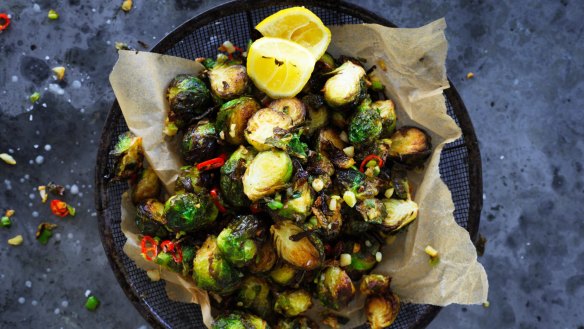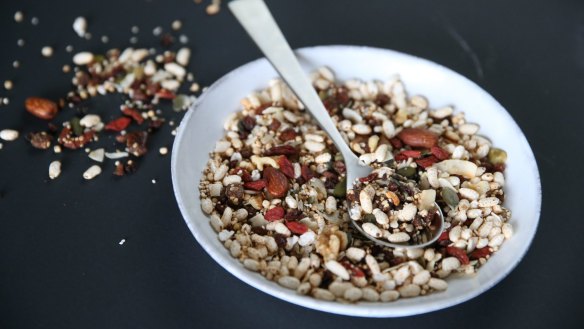Beyond beans: How to get enough fibre when you have a food intolerance

If you're like most adults, you're finding it difficult to get enough fibre in your diet. Though the average recommended daily intake is 25 grams for women and 38 grams for men, most Americans only consume about half of what they're supposed to.
If you have coeliac disease, a wheat-related intolerance or irritable bowel syndrome, you're probably finding your attempts to close the "fibre gap" even more challenging. How can you get enough fibre when you can't consume bread or other fibre-rich foods, such as beans and some vegetables?
Why does it even matter that you try? To begin with, fibre is important for digestive health, including providing food for the beneficial bacteria in our gut, or large intestine. A high-fibre diet can also help lower your "bad" LDL - or low-density lipoprotein - cholesterol, prevent blood-sugar spikes after a meal and keep you feeling full longer.
But the benefits of fibre go even deeper. In February, an analysis of almost 250 studies on carbohydrate quality and human health confirmed what should come as no surprise - that eating lots of fibre from vegetables, fruits, and whole grains can decrease your risk of dying from heart disease and cancer.
Here's what you need to know to protect your health if a food intolerance means you have to leave some fibre-rich products on the table.
Build your gluten free-diet around fresh vegetables, fruits, dried beans, peas and lentils, nuts and seeds, and experiment with gluten-free grains.Alicia Romano, Academy of Nutrition and Dietetics
Coeliac disease or gluten/wheat sensitivity
People who have been diagnosed with coeliac disease have to completely avoid gluten, found in wheat, rye and barley, as well as variations of wheat including spelt, emmer (farro), einkorn and Kamut. People with non-coeliac gluten or wheat sensitivity may have to severely limit, or sometimes completely avoid, gluten-containing grains - or just wheat - to manage symptoms. Unfortunately, that means they have to avoid grains that are excellent sources of fibre, if consumed as whole grains.
This doesn't mean a gluten-free diet must be lower in fibre, said Alicia Romano, a specialised ambulatory dietitian at Tufts Medical Centre in Boston and a spokeswoman for the Academy of Nutrition and Dietetics. "If you are filling your plate with whole foods in addition to a variety of gluten-free grains, fibre intake should be ample on a gluten free diet," Romano said. "Build your gluten free-diet around fresh vegetables, fruits, dried beans, peas and lentils, nuts and seeds, and experiment with gluten-free grains."
Romano said that removing wheat - a staple grain in the American diet - can be a big change, but the real problem is that many Americans don't replace it with alternative sources of fibre. She attributes this to the fact that many people aren't familiar with how to find or cook gluten-free grains. She recommends her patients start with easy-to-find, simple-to-prepare brown rice, wild rice, quinoa and gluten-free oats, then branch out to grains such as buckwheat, teff, amaranth and millet.
Vegetables are nutritious, high-fibre, naturally gluten-free foods - and something most of us could benefit from eating more of. Fibre-rich starchy vegetables include winter squash, green peas, corn, and potatoes and sweet potatoes with the skin. Some of the best non-starchy vegetable options are leafy greens, asparagus, mushrooms and cruciferous vegetables such as brussels sprouts, broccoli, cauliflower and cabbage.
Note that none of these is a processed food. Although things are changing, many gluten-free processed foods have traditionally been low in fibre and filled with things such as tapioca or cornstarch.
"In terms of packaged foods, there certainly has been an improvement overall with the variety of fibre-rich gluten-free alternatives available," Romano said, pointing to pastas made from beans, lentils, brown rice and quinoa. She also said cereal bars, cereals and granolas made from gluten-free grains, nuts and seeds are becoming more readily available. "When choosing packaged gluten-free foods such as pasta, breads and cereals, aim for brands with 3 grams of fibre or more per serving."
Along with processed foods, I don't encourage fibre supplement use for people with coeliac or wheat allergy or for most other people. It's better to get your fibre through foods rather than supplements, because fibre-rich foods are full of other important nutrients. It's fortunate that people who have trouble digesting gluten or wheat still have many other fibre-packed foods to choose from.

Fructans and irritable bowel syndrome
People with irritable bowel syndrome often follow a low-FODMAP diet to manage their symptoms. FODMAP stands for Fermentable Oligo- Di- and Monosaccharides and Polyols. These include lactose, fructose, sugar alcohols and specific types of fibre - the oligosaccharides - found in many wheat, rye barley, beans, nuts and many vegetables. Although FODMAPs are healthy for most people, for others, consuming FODMAPs can cause abdominal pain, distention and bloating, along with diarrhoea, constipation or both. For example, broccoli, asparagus, onions and garlic provide good food for our gut bacteria but may leave people with IBS unable to leave the house.
The goal of a low-FODMAP diet, according Maine-based dietitian Patsy Catsos, author of The IBS Elimination Diet and Cookbook, isn't to give up fibre but to consume the right ones. "With a low-FODMAP diet, we're trying to omit the most rapidly fermenting fibres because they can cause gastrointestinal distress, but we're trying to still consume slowly fermenting fibre," Catsos said. "It's not the idea to starve the gut. This is not meant to be a low-fibre diet."
Examples of slow-fermenting fibre includes resistant starch, which is found in oats, cooked and cooled starchy carbohydrates - including rice and potatoes. In addition, a low-FODMAP diet allows one or two small portions of foods that are moderately high in FODMAPs at each meal or snack - for example, half a cup of cooked oatmeal, two tablespoons of nuts, half a cup of berries or a small orange, or half a cup of cabbage or cooked kale. Catsos said that even with the limited portion sizes, these foods can contribute a healthy amount of fibre when eaten throughout the day. Plus, whole grains such as brown rice, buckwheat, quinoa and millet, as well as dark leafy greens such as arugula, spinach and Swiss chard, offer fibre without the FODMAPs.
"The low-FODMAP diet is more than just a list of low-FODMAP foods and high-FODMAP foods," Catsos said. "You need to have a strategy and a plan. It's meant to be a learning diet, not a permanent diet." The elimination phase helps people learn whether FODMAPs are causing their symptoms, and the challenge phase helps them discover which specific FODMAPs trigger symptoms and what their personal tolerance levels are. A 2017 study found that while fibre intake dropped below recommended levels during the elimination phase of the low-FODMAP diet - something Catsos says doesn't have to happen if the diet is well-planned - it increased to adequate levels as higher FODMAP foods were reintroduced. "You leave a lot of learning on the table if you don't go through the reintroduction phase," Catsos said.
If you have IBS and are struggling to find fibre-rich foods you can tolerate, be careful about turning to fibre supplements. Though there is evidence that psyllium-based supplements can ease symptoms related to excess gas production in people with IBS, supplements containing wheat bran, inulin or chicory root, which are high in FODMAPs, could make symptoms worse.
The Washington Post
Read more: